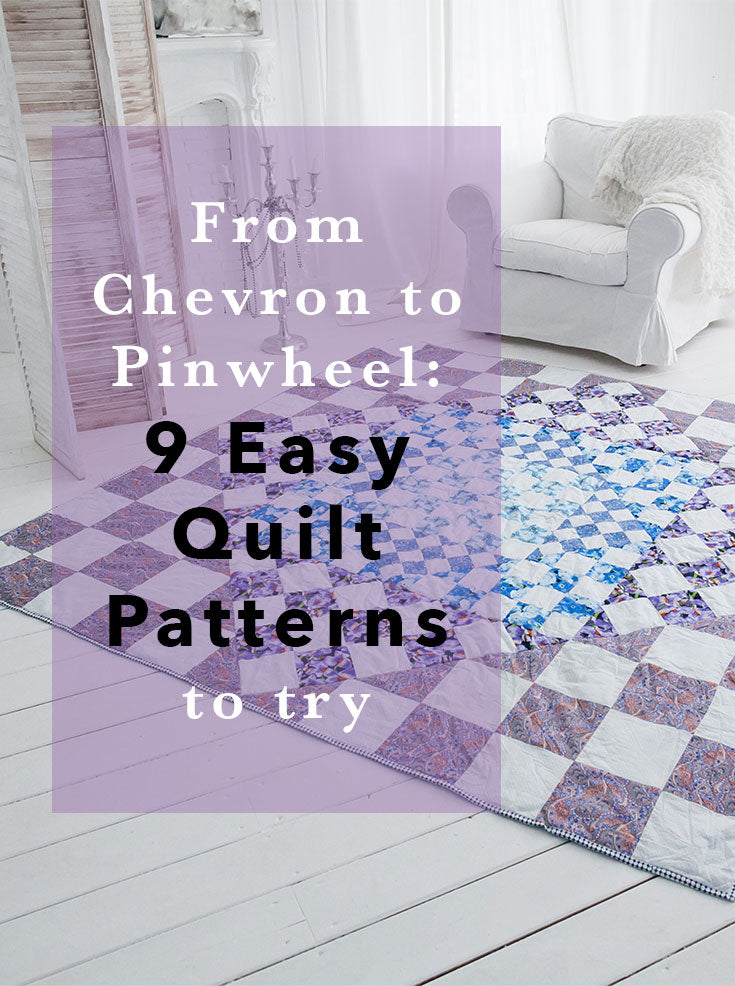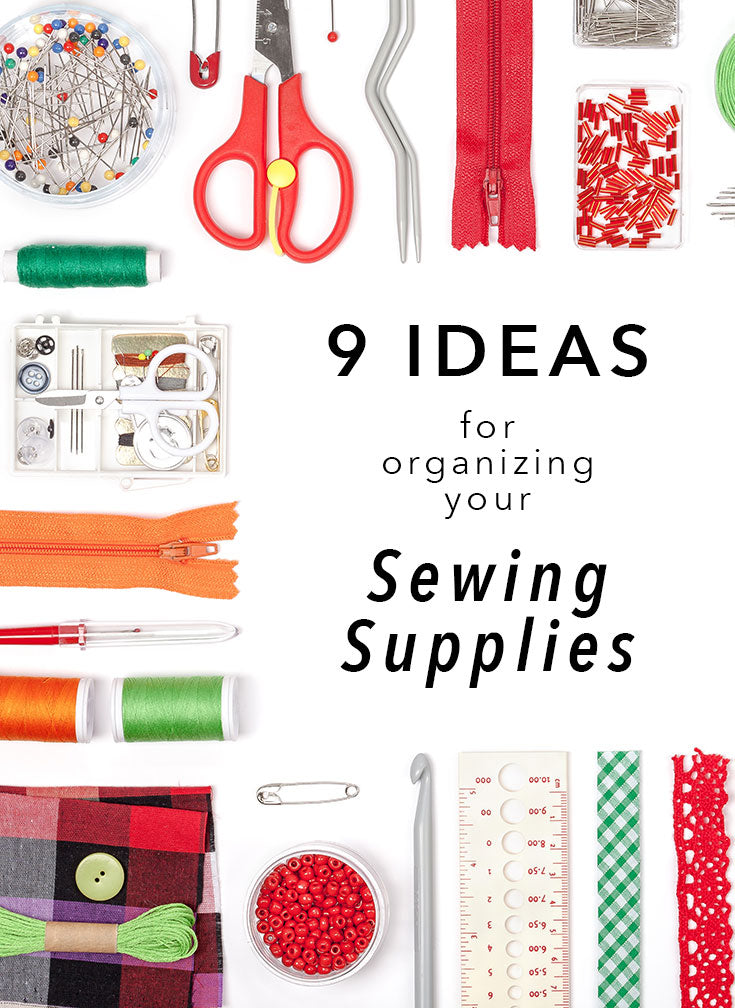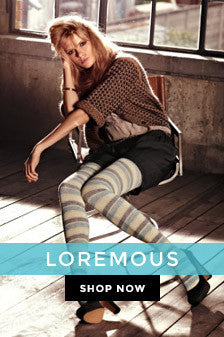Blog » Supplies and Notions
-
From Chevron to Pinwheel: 9 Easy Quilt Patterns to Try

Break out your betweens and grab your low-loft batting because you're going to love these deceptively easy quilt patterns.
From a classic mid-century chevron motif to an artsy kaleidoscope design, they only look complicated. You won't believe how much fun you're going to have creating your family's next heirloom treasure.
Chevron
There are as many methods for piecing a chevron motif as there are spare bobbins in your sewing box, but this easy quilt pattern for the classic chevron, found over at KelbySews, is a keeper.
We love it because it shakes up the “usual” chevron construction and features a combination of large and small squares. Collect the prettiest fabrics you can find—and don’t forget to keep your iron handy to press open the seams—and you can easily create a visual masterpiece that echoes the vintage pop of the 1950s.
Hunter's Star
The Hunter's Star quilt block may look difficult, but we like it a lot it because it's really a simple 16-patch that utilizes two uncut blocks in each row. All other blocks are simple half-square triangles pieced together to form the design. You'll find an easy Hunter's Star pattern and tutorial by Janet Wickell, quilting expert, at About.com. One tip, though—not unlike the chevron design, the Hunter's Star requires a little extra attention to detail to ensure all the points line up precisely.
Kaleidoscope
A relatively modern design, the Kaleidoscope quilt wasn’t seen much before the mid-60s. Why? The colours and designs of fabric required in specific amounts to create this motif wouldn't have been feasible in the early days of quilting. Unlike more traditional motifs that made good use of whatever fabrics the lady of the house happened to have on-hand, the kaleidoscope is an art quilt that evolved as quilting became more pastime and less necessity.
To make yours, see the Kaleidoscope Pattern by Janet Wickell available at About.com.
Log Cabin
A favourite for quilters of all skill levels, the Log Cabin may be the most versatile patch in our repertoire. We love it most because it's an easy quilt pattern for using up small strips and pieces. Then, we love it all over again for its versatility.
The Log Cabin can be arranged to form a variety of designs. Make a traditional block, like this one found over on QuiltSocial.com, or go wild with zany-coloured strips to form a diamond or zigzag quilt. A simple and easy quilt for sure, but still quite satisfying.
Attic Window
An easy-to-handle technique for piecing the multi-dimensional Attic Window block can be found on Straw.com. One of our favourite easy quilt patterns when done correctly, the Attic Window forms a breathtaking optical illusion, yet it's deceptively simple to make.
This block sometimes utilizes a single square of print fabric in the middle of each window pane—forming the view from the attic. When the quilt is complete, the illusion is striking.
Rail Fence
Easy enough for beginners, the Rail Fence pattern over on About.com gets done quickly when you use strip-piecing techniques to create your squares. Once pieced and cut to the appropriate sizes, blocks are simply placed in alternating vertical and horizontal positions to form a zigzag motif.
We love the Rail Fence because it's super simple, and there are no pesky points to line up.
Pinwheel
Straw.com offers up a whole page of easy quilt patterns dedicated to the traditional Pinwheel, ranging in difficulty from easy cut-and-piece to designs that use paper-piecing. If you like the whimsical Pinwheel pattern, this link is a jackpot of fun and fabulous ideas.
We love every variation on the classic Pinwheel, because each one creates dynamic movement and flow.
Bear's Paw
Using a combination of half-square blocks, uncut blocks and strips, the Bear's Paw makes a lively motif that adapts well to quilts of all sizes. Easy to cut and relatively easy to piece with minimal attention to point placement, the Bear's Paw pattern is big on tradition.
We like it because it's a classic design. You'll like it because it's a cinch to construct—and it looks much more complicated when you’re done.
Four-Patch
No list of easy quilt patterns would be complete without the most basic one of all: the Four-Patch. Use uncut squares, half-triangle squares or a combination of the two to create an assortment of simple or complex designs that go together to make surprisingly intricate patterns.
We love the Four-Patch block so much we couldn't leave it out. We're sure you're going to love it too.
Easy quilt patterns: because who needs the stress?
When it's time to bust out the rotary cutter and rifle through all your favourite fat quarters, don’t forget these nine easy quilt patterns. Whether you’re impatient and want to get started in a hurry, or you’ve got a reason to quickly construct a beautiful quilt, these patters will help you whip up a work of textile art in record time.
Ready to get started? Runaway Quilting has everything you need
Need quilting supplies or notions to get started on your easy quilt patter? You’re in the right place.
-
9 Ideas for Organizing Your Sewing Supplies

Most busy quilters have a lot more enthusiasm for their craft than they do for the dreaded task of keeping their sewing rooms tidy.
Let’s face it—creative people thrive in a bit of a mess sometimes. Still, when it's getting difficult to find sewing supplies or embarrassing to invite people into your creative space, it's time to get organized. These ideas can help a sewing room look and work as well as your quilts do.
Ruler storage
Angie Padilla taught herself to sew and to quilt. Now she offers some great ideas that can help teach you to organize your grid rulers better. Like many of you, she has collected a variety of sewing and quilting rulers in all shapes and sizes. Proper storage can make these rulers easier to find and keep them from getting damaged.
Pegboards
If you're short on space, you might not want to waste your walls. You can organize and hang all sort of sewing supplies from pegboards. The Stitching by the Lake blog shows some good examples of how a pegboard made use of wasted space on the wall behind the door. In this case, it was used to hang cutters, shears, and grid rulers.
Shelving
Adding shelves directly over a work table is another great idea from Stitching by the Lake. It's fairly easy to install sturdy, inexpensive shelves on the wall. This idea makes good use of space and keeps things handy right overhead.
Fabric racks
Do you have rolls of fabric that you've simply been standing in the closet or against the wall? If so, you might get some inspiration from the Real Simple blog. They used a wall-mounted bike rack to hang fabric rolls. This keeps them off the floor and displays them in an appealing manner. Of course, you can purchase a fabric rack that has been made to support heavy rolls of fabric too.
Storage cubes
Some quilters and crafters live in apartments or small homes. If you don't have the luxury of using an entire room to work, you might just dedicate a small corner of a room. Inexpensive storage cubes and cabinets can contain a lot of sewing supplies in a tiny space. If you are really cramped, you can even place a board across two of the cabinets to use as a work table. Apartment Therapy has some images that should help spark ideas.
L-shaped table
One reason that many rooms waste space is because most furniture gets stacked against the walls. You can purchase an L-shaped table that offers you a place for your sewing machine on one side and a place to cut or mark fabric on the other side. Sew Many Ways has some ideas to create one of these tables out of other tables or storage units.
Car caddy
Many people regard their craft as a social activity. A convenient car caddy can give you a way to cart the essentials around to your friends’ houses, classes, or anywhere else you might go. You might purchase a caddy that's perfectly suited to notions that you frequently transport. Alternatively, here's a really cute car caddy that Karen of Sew Many Ways created out of some extra fabric and a plastic bucket. You can also buy or make inserts that have pockets and slip right into the buckets.
Organizers for tiny things
Wise people say that you should never sweat the small stuff. At the same time, smaller sewing supplies often present the largest challenge when it comes to keeping things organized and contained. You may want to use a notion organizer that has a lid, so you don't have to worry about dropping it. The clever folks at Pick up Some Creativity used a recycled cupcake container as a temporary solution.
Fabric bin
Most fabric comes folded. It might be easier to keep it that way until you are ready to use it. You can purchase stacking bins or drawers that can store quite a bit of fabric in a small space, as demonstrated by the organizational whizzes at Lasting Order. Transparent drawers make it easy to pick out the right print if you'd rather not take the time to label everything.
Ready to organize your sewing supplies?
It's easier to have an organized sewing room, if you can design it with organization in mind from the very beginning.
At the same time, don’t despair because your sewing room has grown a little cluttered. You can still use a few of these ideas to contain your collection of sewing supplies a little at a time. Some of these tips may even help you find the space to begin crafting even if you didn’t think you had enough room before.
Of course, if you need more sewing supplies… You’re in the right place. Runaway Quilting has everything you need.
-
9 Sewing Notions You Didn't Know You Needed

Whether you've been quilting for 40 years or 40 days, you’ve probably slipped into a routine of using the same sewing notions to complete various tasks. Certainly, familiar tools can produce predictable results. On the other hand, you might find that a new or different gadget allow you to work faster or up your game.
These suggestions should introduce you to new tools, teach you to use your sewing notions in a better way, or help you find better versions of the tools that you already use.
Rotary cutters
Some people regard rotary cutters as straight-line tools, and scissors as the right device to cut out curves. However, smaller cutters can also make the task of cutting curved patterns easier. This is particularly true for people who would rather not strain their hands or are simply not that good with scissors. If you've been frustrated with a rotary cutter in the past, the one you have might be too large.
Cutting mats
If you haven't used a rotary cutter before, you should know that you'll also need a cutting mat. Of course, these mats are handy even if you use a scissors because they provide a flat surface and measured grid. Once you try a mat, you may never go back to cutting on the living room floor again.
Seam iron
While this might not usually fall in the category of sewing notions, a good iron is an essential tool to produce professional results. After the item has been stitched, the heat helps to sink stitches and press the fabric flat. This step can also make up for minor irregularities or imperfections in stitching.
Here’s an important note, though: a seam iron is not necessarily a steam iron. Steam may distort some fabrics.
Transparent grid rulers
Obviously, you need to measure fabric and mark lines. If you're still using the ruler that you borrowed out of your child's pencil bag, you're wasting time and probably not working as quickly and accurately as you could with a transparent ruler. Some using rulers will make you lazy, but actually, they will make you more productive and precise.
Hera marker
Lots of quilters and seamstresses have tried a variety of different marking tools without enjoying the results. Inferior tools may simply not work, bleed through to the other side, or even leave stains. Unlike other tools, however, a hera marker leaves invisible creases on fabric. You can use this tool to make straight or curved creases. Of course, the crease also makes it easy to fold fabric. This is one of those sewing notions that you'll wonder how you lived without—you have to try it to believe it.
White marking pen
Sometimes you do need to mark your fabric, and a simple crease won't do. However, even the best colored markers may not show up well on bright prints. A white marking pen will do the trick—unless of course you’re using white fabric.
Seam ripper
It's a sad but true fact that every seam won't meet your expectations. Lucky for you, you don't need to set your work in stone but can rip out stitches and try again. You just want to be sure that you use this sharp tool correctly, so you can start over fresh. My Childhood Treasures offers a pretty quick tutorial about two effective ways to use a seam ripper correctly.
Thread snippers
Consider adding thread snippers to your collection of sewing notions; you’ll quickly come to keep them right beside your sewing machine for quick snips. They’re smaller, more accurate, and faster than the large pair of fabric shears that you might use for cutting.
Fabric shears
Any serious quilter should invest in good shears—and then use them only for fabric in order to make sure they stay sharp.
With all these sewing notions… Where will you start?
You can certainly find a remarkable variety of sewing notions on the market—and it's hard to know which ones will offer you the best value for your money.
You might start shopping by considering those things that frustrate you about your craft. If you've hit a roadblock, you can bet others have had the same problem and devised with some creative solutions.
Ready to get started? Runaway Quilting has everything you need
Looking to stock up on sewing notions? You’re in the right place.




